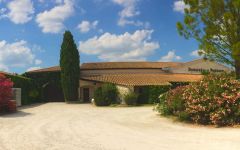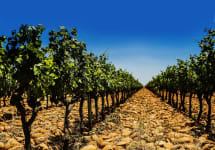Domaine de la Mordoree Chateauneuf-du-Pape La Reine des Bois 2003
-
Robert
Parker -
Wine
Spectator -
Jeb
Dunnuck -
Wine
Enthusiast



Product Details
Your Rating
Somm Note
Winemaker Notes
Professional Ratings
-
Robert Parker's Wine Advocate
A wine I’ve been lucky enough to have numerous times recently, the 2003 Chateauneuf du Pape Cuvee de La Reine des Bois is gorgeous. Quite possibly the wine of the vintage, it shows thrilling levels of blackberry, licorice, toasted bread, and garrigue to go with a full-bodied, massive, yet layered and seamless feel on the palate. There’s none of the rusticity or coarse tannin that’s common in the vintage, and it possesses beautiful purity, sweetness of fruit and length. Drink it over the coming 2-4 years.
-
Wine Spectator
Captivating raspberry ganache and cassis aromas and flavors pump through this richly layered beauty, with notes of melted licorice, bittersweet cocoa, fig paste and hoisin sauce. The long, driven finish drips with fruit and minerality, with seriously embedded structure. Best from 2010 through 2030.
-
Jeb Dunnuck
The 2003 Domaine de la Mordorée Châteauneuf-du-Pape Cuvée de la Reine des Bois shows an amazingly dark and completely opaque color along with a to die for nose of raspberries, cassis, licorice, violets and integrated smoky wood notes. With air, minerals and subtle spice notes start to emerge and even for being so ripe and young, there's lots of complexity and this is not a monolithic fruit bomb. The palate actually started out slightly disjointed and showed excessive, bitter tannins but after 7 hours of being open, everything came together and is simply stunning. Full bodied and powerful with ripe, rich fruit. The texture is definitely on the heavy side but there is so much fruit and structure underneath all the fruit. This finishes very long with substantial, sweet tannins. This is more powerful than the 2000 (but not as open and lush) and not as seamless as the 2001. This was double decanted at 1 O'Clock and left in the cellar with the cork out until 7 O'clock and then consumed over the evening. This seems almost impervious to air and more time would have been better.
Rating: 97+ -
Wine Enthusiast
A dark, brooding wine, packed with wood and dry tannin flavors. At the same time, the fruit is huge, with chocolate, dark plum, cassis and sweetness. This is a dense wine that is going to be hugely impressive after 5 years of aging. Imported by Kysela Père et Fils.
Other Vintages
2020-
Jeb
Dunnuck -
James
Suckling - Decanter
-
Robert
Parker
-
Jeb
Dunnuck -
Robert
Parker -
Wine
Spectator
-
Jeb
Dunnuck -
Robert
Parker -
James
Suckling
-
Jeb
Dunnuck -
Robert
Parker -
Wine
Spectator -
Wine
Enthusiast
-
Robert
Parker
-
Robert
Parker
-
Robert
Parker -
Wine
Spectator
-
Robert
Parker -
Jeb
Dunnuck -
Wine
Enthusiast
-
Robert
Parker -
Wine
Spectator -
Wine
Enthusiast
-
Robert
Parker -
Wine
Spectator
-
Robert
Parker
-
Robert
Parker
-
Jeb
Dunnuck -
Robert
Parker -
Wine
Spectator
-
Wine
Spectator -
Robert
Parker
-
Robert
Parker






Coming from a long line of winegrowers, the Domaine de la Mordoree was created in 1986 with the philosophy of growing the best possible wines. To that purpose, the best plots and the finest varieties have been chosen, and the winemakers implement cultivation methods that aim at really preserving the environment, while combining tradition and modernity.
In the course of time, 55 hectares of vineyards have been grown, spread over 35 different plots and 8 communes. This division comes from the decision of choosing the best "terroirs" with a wide variety of microclimates.

With bold fruit flavors and accents of sweet spice, Grenache, Syrah and Mourvèdre form the base of the classic Rhône Red Blend, while Carignan, Cinsault and Counoise often come in to play. Though they originated from France’s southern Rhône Valley, with some creative interpretation, Rhône blends have also become popular in other countries. Somm Secret—Putting their own local spin on the Rhône Red Blend, those from Priorat often include Merlot and Cabernet Sauvignon. In California, it is not uncommon to see Petite Sirah make an appearance.

Famous for its full-bodied, seductive and spicy reds with flavor and aroma characteristics reminiscent of black cherry, baked raspberry, garrigue, olive tapenade, lavender and baking spice, Châteauneuf-du-Pape is the leading sub-appellation of the southern Rhône River Valley. Large pebbles resembling river rocks, called "galets" in French, dominate most of the terrain. The stones hold heat and reflect it back up to the low-lying gobelet-trained vines. Though the galets are typical, they are not prominent in every vineyard. Chateau Rayas is the most obvious deviation with very sandy soil.
According to law, eighteen grape varieties are allowed in Châteauneuf-du-Pape and most wines are blends of some mix of these. For reds, Grenache is the star player with Mourvedre and Syrah coming typically second. Others used include Cinsault, Counoise and occasionally Muscardin, Vaccarèse, Picquepoul Noir and Terret Noir.
Only about 6-7% of wine from Châteauneuf-du-Pape is white wine. Blends and single-varietal bottlings are typically based on the soft and floral Grenache Blanc but Clairette, Bourboulenc and Roussanne are grown with some significance.
The wine of Chateauneuf-du-Pape takes its name from the relocation of the papal court to Avignon. The lore says that after moving in 1309, Pope Clément V (after whom Chateau Pape-Clément in Pessac-Léognan is named) ordered that vines were planted. But it was actually his successor, John XXII, who established the vineyards. The name however, Chateauneuf-du-Pape, translated as "the pope's new castle," didn’t really stick until the 19th century.
